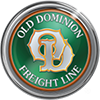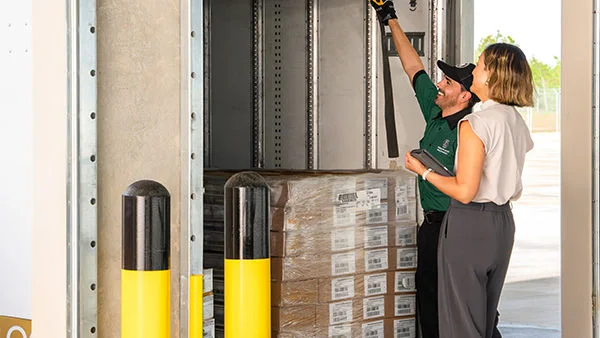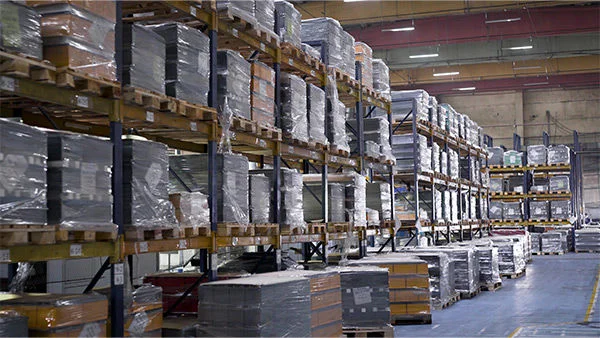Partnering with the Right Freight Carrier: Reducing Risk Through Smart Collaboration
In this Article
- Key Risks in Freight Logistics: Learn how delays, damages, compliance issues, and unexpected costs can impact your business.
- Selecting the Right Carrier: Look for a partner that offers reliability, capacity, and seamless customer service.
- Strategies for Collaboration: Actionable tips for building trust, sharing data, and setting expectations with your carrier.
- Long-Term Benefits: Understand how strategic carrier relationships can stabilize your supply chain and delight your customers.
The top risk factors to consider are delays, damage, compliance, and unexpected charges.
Selecting the best LTL freight carrier for your business’s shipping needs is an important decision that has a significant impact on your bottom line. Your decisions on carrier partnerships affect not only your supply chain stability and cost basis, but also your customer service, and overall reputation.
There are two fundamental areas to consider when making a decision of this importance.
First, it’s critical to understand all the potential risk factors at play when it comes to shipping. Second, you want to consider the positive traits you should look for in a transportation partner that create the best chances for a lasting, mutually beneficial relationship.
The top-line risk factors to consider when choosing a freight carrier are delays, damage, compliance, and unexpected charges.
- Delays are directly correlated with carrier reliability.
- Damage is a function of mishandling or inadequate protection.
- Compliance issues tend to stem from violations of agreements, regulations, or contracts.
- Unexpected charges are typically a consequence of those three prior risks.
You’ll find more detail on each of these areas below.
Any carrier you consider working with will have its own internal practices that mitigate or exacerbate each of these risks. In addition, different carriers have differing levels of partnership and collaboration depth they are willing to undertake. It’s important to evaluate all of these factors before making a final decision on using a particular carrier. Once a carrier has your business, it’s critical that you continue to evaluate its performance on an ongoing basis.
Key Risks to Consider in Freight Logistics
Key Risks to Consider in Freight Logistics
Delays
Delays are difficult to completely eliminate from your transportation equation, due to the inherently unpredictable nature of motor vehicles, the supply chain, and weather. With proper capacity and redundancy, however, delays can be mitigated significantly.
Thus, it’s fair to look at a carrier’s on-time delivery percentage as a key metric of its performance, and the most direct indicator of carrier reliability. If a carrier cannot tell you their on-time percentage, they should be eliminated from consideration, except in emergency situations.
Delays affect your bottom line in two important ways: in the short term as additional charges, and in the long run as reputational damage.
Increasingly, consignees employ supplier scorecards to rate their partners on a variety of factors including On-Time In-Full (OTIF) delivery. Even if fees are not incurred on a late delivery, expect missed shipping deadlines to be noted, and factored in when your customers periodically evaluate their business practices.
Damage
Freight damage is one of the most frustrating issues shippers face.
Not only is it expensive, but establishing responsibility can be a fraught process. Merchandise that is damaged en route is costly to either the consignee, the shipper, or both.
Again, reputational damage is accrued in addition to monetary cost. While inadequate packaging can be an issue, improper handling and accidents are more common. If damage occurs, you deserve a candid and transparent response from any carrier you work with. In addition, there should be a clear path to resolve any dispute.
Compliance
Compliance issues break down into two broad categories.
- Carrier-side issues include things such as complying with hours-of-service regulations, maintaining accurate maintenance logs, as well as customs procedures and other regulatory factors.
- Shipper-facing issues include shipment violations regarding delivery windows, as well as disputes over loading and unloading agreements that may differ from consignee to consignee.
Violating agreements, industry regulations, or contracts can disrupt shipments and result in costly fines, fees, and unnecessary logistical overhead.
Regardless of where compliance issues sit, it is imperative that any carrier you work with have a comprehensive understanding of the issues, as well as experience in mitigating or eliminating them.
Unexpected Costs
While all carriers will quote a price up front for a given shipment along a given route, that quote is only useful if it considers any additional fees, fines, and costs associated with delayed freight, damaged goods, and compliance issues, all of which are typically applied on the back end of the shipping process.
These factors have been known to inflate costs significantly. These unexpected fees can have a significant impact on the overall profitability of your product.
Inaccurate shipment information, such as weight, classification, or dimensions, could also lead to a different freight rate than what was initially quoted. Investing in tools to accurately measure your freight can mitigate re-weigh or re-classification of your shipment.
Unexpected costs are one of the greatest sources of friction in shipper/carrier relationships. The antidote to the negative impacts of these costs is a strong, transparent relationship with your carrier. Potential back-end charges and their likelihood should be an open topic from the word go, and both sides should be ready and willing to collaborate on solutions.
Carrier Selection: Key Considerations
Carrier Selection: Key Considerations
Selecting the right carrier for your shipping needs is not a decision that should be undertaken lightly. Ideally, these relationships are built for the long haul. Changing carriers has significant organizational cost and means starting over from scratch in many ways, so it should be avoided where possible.
There are several key factors to consider when choosing a transportation partner.
Reliability and Reputation
On-time delivery is one of the best overall indicators of a carrier’s operational excellence. Mastering the ability to consistently make deliveries on time over tens of thousands of shipments per year tests a host of organizational, logistical, and operational faculties.
It’s reasonable to inquire about metrics with representatives of any carrier you are considering, but it’s also important not to rely solely on a company’s opinion of itself. Testimonials, overall time in business, historical performance data, and third-party evaluations are all useful tools in sizing up potential transportation partners. Mastio & Company conducts an annual study and report on LTL carriers in the US, evaluating each on a list of 28 key attributes.
Coverage and Capacity
One factor to consider is whether a given carrier adequately serves the lanes you need to ship in. However, if your business intends to expand, you want to make sure you are working with a carrier that operates in the areas you intend to expand into. If you think you may need coast-to-coast coverage down the line, you can avoid the hassle and overhead that comes with switching carriers by working with a nationwide transportation partner off the bat.
When looking at coverage, make sure you also consider capacity. The amount of territory a carrier covers only matters if they have the capacity to not only move freight across that territory, but to do it despite unexpected situations, inclement weather, or last-minute changes.
Excess capacity is the solution to all of these problems. Don’t just ask whether a carrier can cover your routes, ask what happens when your shipment volume increases suddenly. Can the carrier handle seasonality in your business? It’s important to partner with an LTL carrier that consistently invests in building capacity in the areas of service centers, equipment, employees, and technology.
If you need to move goods to or from Canada or Mexico, you will find that different carriers have different comfort levels with these lanes, which require additional regulatory and compliance factors. Some carriers are able to coordinate transoceanic services that dovetail with your domestic needs.
If you regularly need to ship within tight time-windows, you may want to consider a carrier with specialized services, such as expedited, guaranteed delivery.
In all of these more complex cases, experience should be one of your primary considerations.
Technology and Communication
It should be easy to communicate with representatives from your transportation partner, in whichever format your prefer.
Digital back-end systems can speak to each other directly and automatically through application program interfaces (APIs). Real-time tracking via electronic communication networks and Internet of Things (IoT) technologies is also becoming standard. Knowing where your shipments are, when they are due to arrive, and the ability to alter their destination while in transit, is another critical functionality your LTL carrier should have.
If you are already operating digitally, make sure any transportation partner you consider working with has the technology stack to accommodate your most advanced needs. If you are still evolving your digital strategy, make sure you are working with a partner who has the resources to help you make the transition smoothly, and at the lowest possible cost.
Strategies for Effective Collaboration
The deeper your collaboration, the more successful you will be.
Strategies for Effective Collaboration
It’s impossible to overstate the importance of the human relationships that form the basis of collaborations between shippers and carriers. The deeper your collaboration with one another, the more successful you will be. Since each party is dependent on the other for the health of their own business, it is in both sides’ interest to be as candid, transparent, and available to one another as possible.
Old Dominion employs four strategic pillars when working with its customers.
Clear Expectations
One of the most important pieces of a strong, collaborative relationship is making sure all parties have total clarity about the terms of their agreements.
Of particular importance is a strong mutual understanding of what happens when circumstances change, contracts move out of scope, or the unexpected occurs. Knowing what kinds of response times you can expect in a crisis is important, as is understanding how carriers cope with weather delays, errors, or other challenges.
Do not hesitate to press them on these topics. Any hesitation or uncertainty on these issues is cause for concern.
Strong Communications to Build Trust
Trust is built in many ways, including dependability, time of relationship, transparency in business dealings, and open, proactive communications. The ability to have open dialogue is essential for the success of any transportation relationship.
Shared Data and Harmonized Technology
In the modern era, shipping is almost as much about moving bits as it is about moving atoms. The more data shippers and carriers can share with one another, the greater their ability to optimize routes, loads, and schedules, all of which can have a positive effect on price.
It’s critical that the data is accurate. Inaccurate shipment data, such as the wrong weight, dimensions, or classification, can result in a different freight rate than what was initially agreed upon. Accurate data enables accurate pricing, which eliminates surprises on your final invoice.
Ongoing Evaluation and Adaptation
Evaluating shipping partners is not something you do once and forget about. It’s critical to create a cadence for evaluating the relationship over time.
Ideally, you want to enlist your transportation partner in the process to make sure you are both incorporating all available information as you make ongoing adjustments. The goal is not to make your next quarter match your last, but to exceed it. Conversely, in the transportation business we know we’re only as good as our last on-time delivery.
Reducing Risk, Partnering for the Long Haul, and Making Your Customers Smile
Choosing a carrier is important, but it comes down to just a few specific areas of focus.
Risks break down in four areas: delays, damage, compliance, and unexpected costs. Partnering with the right carrier can mitigate all of these factors. The longer, deeper, and more transparent your collaboration becomes, the more predictable your shipping will be. The more efficient your operations are, the happier you will make your customers.
Look for reliability and reputation in certified carriers with excess capacity that serves both the areas you currently operate in, and ones you have targeted for the future.
After that, strive to find partners where strong, open, transparent communications are the norm. Align your digital operations with theirs to find even more efficiency and evaluate your partnership and processes regularly.
Overall, take an approach to your carrier relationships that focuses on long-term strategy, rather than short-term tactics. And don’t be afraid to ask the hard questions. Coordinated planning and execution are the keys to a stable and lasting shipping relationship that minimizes delays, damages, and unexpected costs.
If you want to know more about Old Dominion’s customer philosophy, how our performance stacks up, or are curious how Old Dominion might fit your shipping needs, our dedicated Solution Specialists are always just a phone call away. Call us at 800-235-5569 or contact our Customer Service team for a response within 1 hour.



